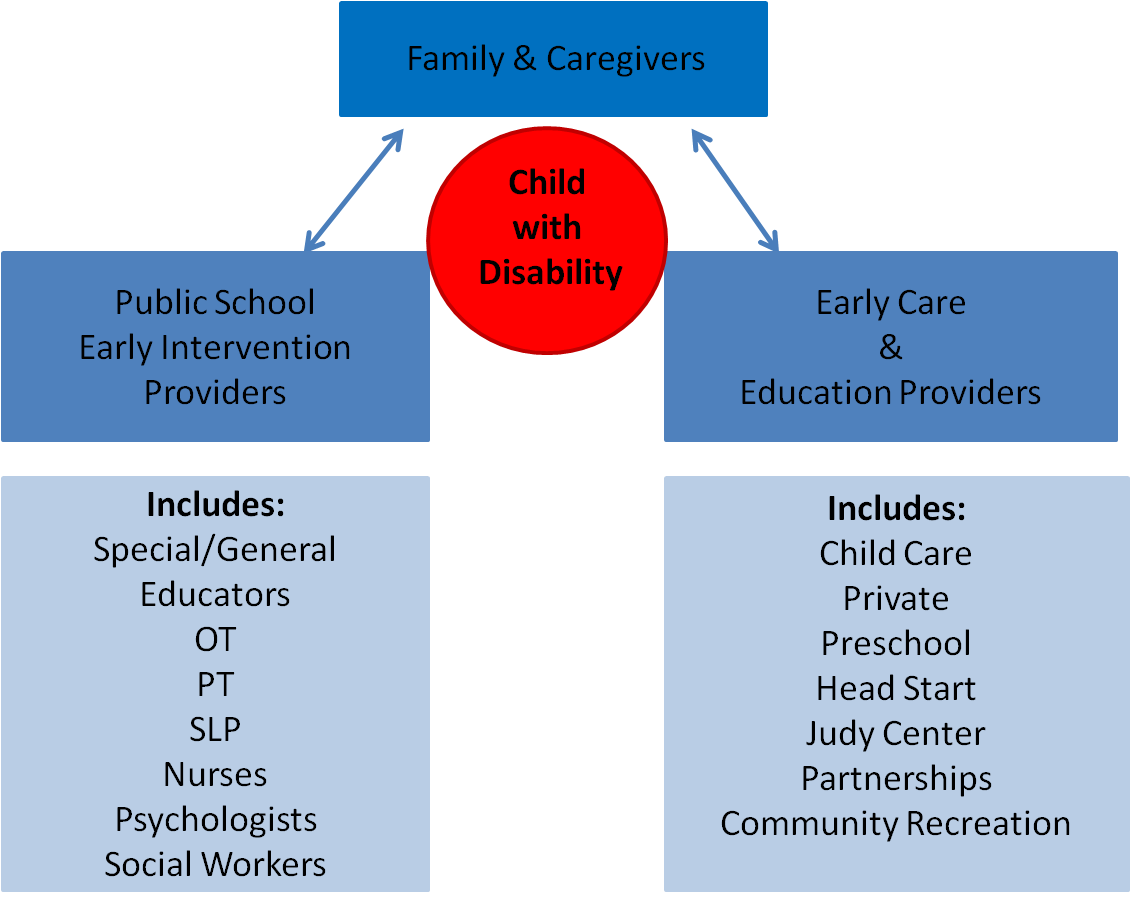Responsibilities of Early Childhood Implementation Teams
An early childhood implementation team supports a young child with a disability in an inclusive early childhood setting(s). Three key partner groups-family/caregivers, public school/early intervention and early care/education providers- collaborate to embed special education and related services for eligible children in the inclusive settings on the NE/LRE Community Circle .
Membership varies on a child’s early childhood implementation team, depending on who will provide the early intervention or preschool special education and realted services specified on each child’s Extended IFSP or IEP. Staff in the early childhood setting in which a child receives his or her services will also influence the team membership.
Core team members interact with a child on a daily or near daily basis.
Core team members typically include parents and caregivers, child care providers, and Judy Center, Head Start, and public and private preschool teachers/assistants.
Extended team members support core team members in embedding recommended intervention within a child’s ongoing routines, activities and/or lessons and interact with a child on a periodic basis.
Extended team members include early intervention specialists, special educators and related service providers as well as medical/health specialists who may assess a child and provide intervention in hospitals, clinics and private offices. Hanft, Shepherd & Read, 2011
Collaboration among partners
Collaboration is an interactive team process that focuses partners on enhancing the development, learning and participation of young children with disabilities in school, community and home environments with their families and typically developing peers. Hanft & Shepherd, 2008.
Collaboration among partners on an early childhood implementation team ensures that each child with a disability has full access to, and participates in typical routines, activities and learning in a community setting with peers without disabilities.
 Collaboration, an umbrella term, includes:
Collaboration, an umbrella term, includes:
- Coaching, Sheldon & Rush, 2010 - Case Tools
- Collaborative Consultation, Kempwirth & Powers, 2011
- Co-teaching, Potts &, Howard, 2011
- Differentiated Instruction, Tomlinson, 2006
- Embedded intervention Project CONNECT, 2010
- Family-Professional Partnerships, Turnbull & Turnbull, 2001
- Integrated Therapy, Giangreco, 2000
Characteristics of collaborative teams
Team members may think they are collaborating when they participate in a monthly team meeting or informal conversation about student progress, plan a lesson with a partner, or coordinate therapy and class schedules. However, simply talking or meeting with partners in inclusive settings is not a collaborative interaction unless all partners embrace and incorporate these team characteristics:
- Voluntary participation with equal partnership among all team members;
- Common purpose for working together i.e., support participation of children with disabilities in inclusive early childhood settings with their peers without disabilities;
- Collective decision making and problem solving;
- Joint responsibility for reaching IEP goals and Extended IFSP outcomes;
- Shared resources e.g., materials, equipment, supplies, personnel, transportation and funds.
Friend, 2000; Friend & Cook, 2009; Thousand & Villa, 2000; Center for Technology in Education, Boundless Learning
Partners on early childhood implementation teams are responsible for working together to:
- Respect each partner’s culture, role and knowledge.
- Connect families to program staff, activities and other families.
- Individualize communication with families.
- Facilitate interaction and learning for all children.


